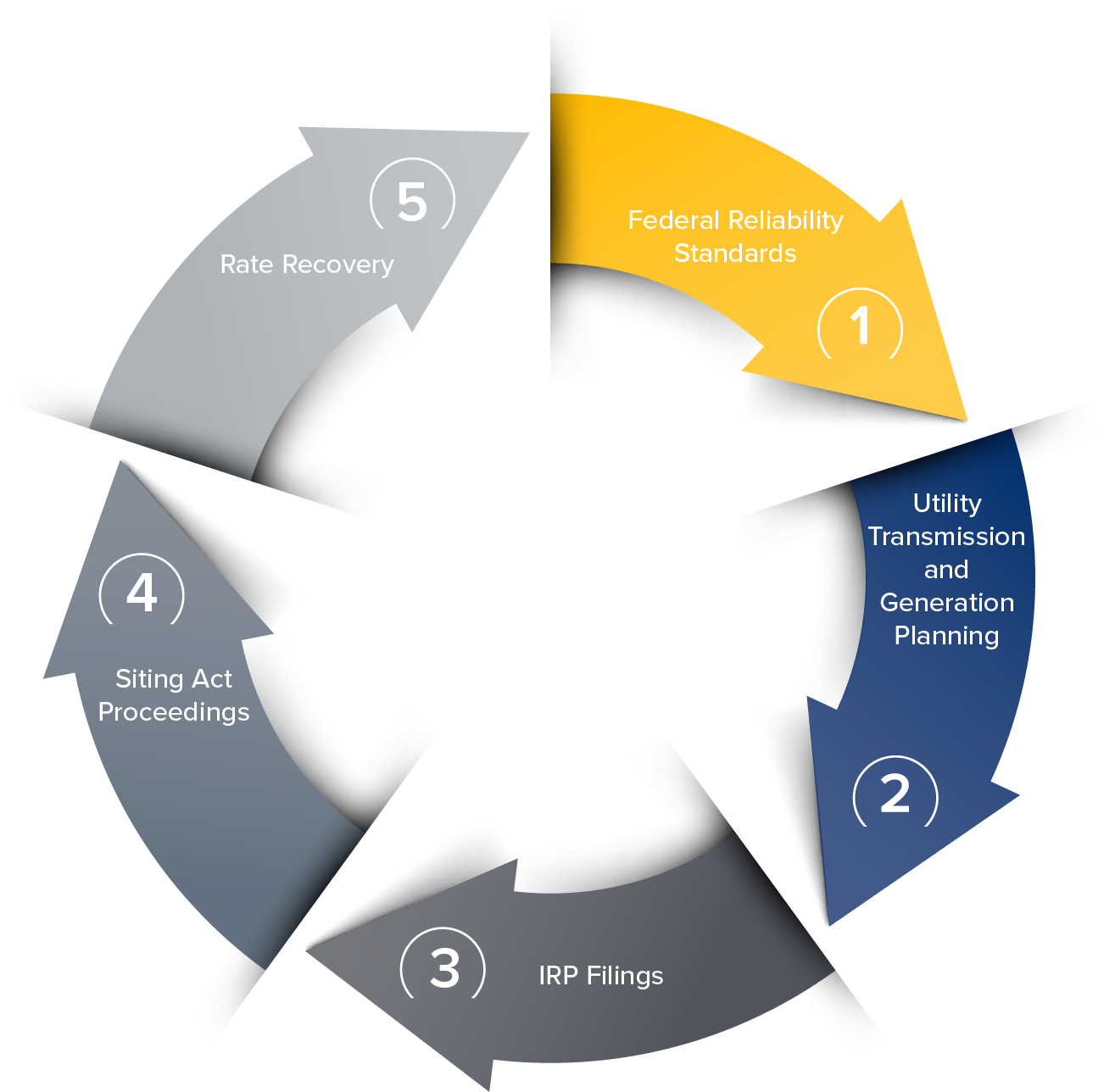This article is based on Belton Zeigler’s presentation to E4 Carolinas' South Carolina Energy CLE on Dec. 18, 2020.
The utility planning and investment cycle begins with planning to comply with Federal reliability standards, proceeds through Integrated Resource Planning reviews at the Commission level, then results in Siting Act proceedings to certificate the construction of new facilities. The utility’s investment in the new facilities is recovered through rate proceedings that follow the commencement or completion of construction.

1. Federal Reliability Standards
Electric utility reliability requirements are established and enforced by the National Electric Reliability Council (“NERC”) under Section 1211(a) of the Energy Policy Act of 1995.
a. Reliability Standards Are Mandatory
The Commission shall have jurisdiction, within the United States, over the ERO [Electric Reliability Organization, i.e., NERC] certified by the Commission under subsection (c), any regional entities, and all users, owners and operators of the bulk-power system, including but not limited to the entities described in section 824(f) of this title, for purposes of approving reliability standards established under this section and enforcing compliance with this section. All users, owners and operators of the bulk-power system shall comply with reliability standards that take effect under this section.
16 U.S.C.A. § 824o(b)(1).
b. Planning Criteria
NERC planning criteria require the utilities have both the transmission and generation assets required to be able to meet forecasted load under contingency situations involving the loss of any one or combination of two major generation assets.
c. Penalties
NERC may impose substantial penalties for reliability violations which can exceed $1 million per violation.1
(1) The ERO may impose, subject to paragraph (2), a penalty on a user or owner or operator of the bulk-power system for a violation of a reliability standard approved by the Commission under subsection (d) if the ERO, after notice and an opportunity for a hearing–
(A) finds that the user or owner or operator has violated a reliability standard approved by the Commission under subsection (d); and
(B) files notice and the record of the proceeding with the Commission.
16 U.S.C.A. § 824o(e).
d. Preemption of State Decisions
FERC may preempt inconsistent state action affecting reliability:
Within 90 days of the application of the Electric Reliability Organization or other affected party, and after notice and opportunity for comment, the Commission shall issue a final order determining whether a State action is inconsistent with a reliability standard, taking into consideration any recommendation of the ERO.
16 U.S.C.A. § 824o(i).
2. Utility Transmission and Generation Planning
The utility’s transmission and generation planning groups identify the facilities’ need for compliance with NERC reliability standards through:
a. Modeling generation adequacy using the utility’s generation resource planning model.
b. Preparing the utility’s annual long and short range transmission system reliability studies required to comply with NERC reliability standards (with generation planning results as a model input).
3. IRP Filings
The utility’s resulting generation and transmission plans are submitted to the Public Service Commission of South Carolina (the “Commission”) under the IRP Statute, S.C. Code Ann. § 58-37-40 as amended by Act No. 62 of 2019.
a. Three Year Cycle
New IRPs must be submitted at least every three years and are subject to review in full adversarial proceedings:
Electrical utilities, electric cooperatives, municipally owned electric utilities, and the South Carolina Public Service Authority must each prepare an integrated resource plan. An integrated resource plan must be prepared and submitted at least every three years.
S.C. Code Ann. § 58-37-40(A);
The commission shall have a proceeding to review each electrical utility's integrated resource plan. As part of the integrated resource plan filing, the commission shall allow intervention by interested parties. The commission shall establish a procedural schedule to permit reasonable discovery after an integrated resource plan is filed in order to assist parties in obtaining evidence concerning the integrated resource plan, including the reasonableness and prudence of the plan and alternatives to the plan raised by intervening parties. No later than three hundred days after an electrical utility files an integrated resource plan, the commission shall issue a final order approving, modifying, or denying the plan filed by the electrical utility.
S.C. Code Ann. § 58-37-40(C)(1).
b. Annual Updates
IRPs are updated annually subject to paper review by ORS:
An electrical utility shall submit annual updates to its integrated resource plan to the commission. An annual update must include an update to the electric utility's base planning assumptions relative to its most recently accepted integrated resource plan, including, but not limited to: energy and demand forecast, commodity fuel price inputs, renewable energy forecast, energy efficiency and demand-side management forecasts, changes to projected retirement dates of existing units, along with other inputs the commission deems to be for the public interest. The electrical utility's annual update must describe the impact of the updated base planning assumptions on the selected resource plan.
S.C. Code Ann. § 58-37-40(D)(1);
The Office of Regulatory Staff shall review each electric utility's annual update and submit a report to the commission providing a recommendation concerning the reasonableness of the annual update. After reviewing the annual update and the Office of Regulatory Staff report, the commission may accept the annual update or direct the electrical utility to make changes to the annual update that the commission determines to be in the public interest.
S.C. Code Ann. § 58-37-40(D)(2).
c. Required Contents
The IRP statute contains an extensive, and somewhat disjointed, set of required contents for an IRP, specifically:
(a) a long-term forecast of the utility's sales and peak demand under various reasonable scenarios;
(b) the type of generation technology proposed for a generation facility contained in the plan and the proposed capacity of the generation facility, including fuel cost sensitivities under various reasonable scenarios;
(c) projected energy purchased or produced by the utility from a renewable energy resource;
(d) a summary of the electrical transmission investments planned by the utility;
(e) several resource portfolios developed with the purpose of fairly evaluating the range of demand-side, supply-side, storage, and other technologies and services available to meet the utility's service obligations. Such portfolios and evaluations must include an evaluation of low, medium, and high cases for the adoption of renewable energy and cogeneration, energy efficiency, and demand response measures, including consideration of the following:
(i) customer energy efficiency and demand response programs;
(ii) facility retirement assumptions; and
(iii) sensitivity analyses related to fuel costs, environmental regulations, and other uncertainties or risks;
(f) data regarding the utility's current generation portfolio, including the age, licensing status, and remaining estimated life of operation for each facility in the portfolio;
(g) plans for meeting current and future capacity needs with the cost estimates for all proposed resource portfolios in the plan;
(h) an analysis of the cost and reliability impacts of all reasonable options available to meet projected energy and capacity needs; and
(i) a forecast of the utility's peak demand, details regarding the amount of peak demand reduction the utility expects to achieve, and the actions the utility proposes to take in order to achieve that peak demand reduction.
S.C. Code Ann. § 58-37-40(B)(1).
d. Standards for Approval
The Commission must approve an IRP if it “determines that the proposed integrated resource plan represents the most reasonable and prudent means of meeting the electrical utility’s energy and capacity needs as of the time the plan is reviewed.” S.C. Code Ann. § 58-37-40(C)(2). The factors that the plan must balance to be determined to be reasonable and prudent include:
(a) resource adequacy and capacity to serve anticipated peak electrical load, and applicable planning reserve margins;
(b) consumer affordability and least cost;
(c) compliance with applicable state and federal environmental regulations;
(d) power supply reliability;
(e) commodity price risks;
(f) diversity of generation supply; and
(g) other foreseeable conditions that the commission determines to be for the public interest.S.C. Code Ann. § 58-37-40(C)(2).
e. Relief
The relief that the Commission may order is the refiling of the IRP addressing the concerns raised by the Commission. S.C. Code Ann. § 58-37-40(C)(3).
f. Prudency
However, acting in compliance with a Commission approved IRP has is not determinative of the prudency of investments in new generation or transmission assets:
The submission, review, and acceptance of an integrated resource plan by the commission, or the inclusion of any specific resource or experience in an accepted integrated resource plan, shall not be determinative of the reasonableness or prudence of the acquisition or construction of any resource or the making of any expenditure. The electrical utility shall retain the burden of proof to show that all of its investments and expenditures are reasonable and prudent when seeking cost recovery in rates.
S.C. Code Ann. § 58-37-40(C)(4).
Although the burden of proof of the reasonableness of all costs incurred which enter into a rate increase request rests with the utility, the utility's expenses are presumed to be reasonable and incurred in good faith.
. . .
This presumption does not shift the burden of persuasion but shifts the burden of production on to the Commission or other contesting party to demonstrate a tenable basis for raising the specter of imprudence.
Hamm v. S.C. Pub. Serv. Comm'n, 309 S.C. 282, 286, 422 S.E.2d 110, 112 (1992).
g. DSM/Energy Efficiency/Demand Shifting
The effects of programs to achieve energy efficiency, demand reduction and demand shifting are included as input into the load growth projection used in resources plans under the IRP. The programs themselves are approved under the authority of S.C. Code Ann. § 58-37-20 and are subject to a requirement that they be “cost effective,” and “environmentally acceptable.”
The South Carolina Public Service Commission may adopt procedures that encourage electrical utilities and public utilities providing gas services subject to the jurisdiction of the commission to invest in cost-effective energy efficient technologies and energy conservation programs. If adopted, these procedures must: provide incentives and cost recovery for energy suppliers and distributors who invest in energy supply and end-use technologies that are cost-effective, environmentally acceptable, and reduce energy consumption or demand; allow energy suppliers and distributors to recover costs and obtain a reasonable rate of return on their investment in qualified demand-side management programs sufficient to make these programs at least as financially attractive as construction of new generating facilities; require the Public Service Commission to establish rates and charges that ensure that the net income of an electrical or gas utility regulated by the commission after implementation of specific cost-effective energy conservation measures is at least as high as the net income would have been if the energy conservation measures had not been implemented. For purposes of this section only, the term “demand-side activity” means a program conducted by an electrical utility or public utility providing gas services for the reduction or more efficient use of energy requirements of the utility or its customers including, but not limited to, utility transmission and distribution system efficiency, customer conservation and efficiency, load management, cogeneration, and renewable energy technologies.
S.C. Code Ann. § 58-37-20.
4. Siting Act Proceedings
Before construction major facilities (generation units over 75 MW or transmission lines over 125kV), the utility must apply for and receive a “a certificate of environmental compatibility and public convenience and necessity” under the Utility Facility Siting and Environmental Protection Act, S.C. Code Ann. §§ 58-33-10, et seq.
a. Standards for Approval
To approve a siting certificate, the Commission must find:
(a) The basis of the need for the facility.
(b) The nature of the probable environmental impact.
(c) That the impact of the facility upon the environment is justified, considering the state of available technology and the nature and economics of the various alternatives and other pertinent considerations.
(d) That the facilities will serve the interests of system economy and reliability.
(e) That there is reasonable assurance that the proposed facility will conform to applicable State and local laws and regulations issued thereunder, including any allowable variance provisions therein, except that the Commission may refuse to apply any local law or local regulation if it finds that, as applied to the proposed facility, such law or regulation is unreasonably restrictive in view of the existing technology, or of factors of cost or economics or of the needs of consumers whether located inside or outside of the directly affected government subdivisions.
(f) That public convenience and necessity require the construction of the facility.S.C. Code Ann. § 58-33-160(1).
b. Alternatives Considered
In addition, newly added sections of the statute require “a demonstration that the facility to be built has been compared to other generation options in terms of cost, reliability, and any other regulatory implications deemed legally or reasonably necessary for consideration by the commission.” S.C. Code Ann. § 58-33-110(8)(a). In addition, “[t]he commission is authorized to adopt rules for such evaluation of other generation options.” Id. Specifically,
[t]he commission may, upon a showing of a need, require a commission-approved process that includes:
(i) the assessment of an unbiased independent evaluator retained by the Office of Regulatory Staff as to reasonableness of any certificate sought under this section for new generation;
(ii) a report from the independent evaluator to the commission regarding the transparency, completeness, and integrity of bidding processes, if any;
(iii) a reasonable period for interested parties to review and comment on proposed requests for proposals, bid instructions, and bid evaluation criteria, if any, prior to finalization and issuance, subject to any trade secrets that could hamper future negotiations; however, the independent evaluator may access all such information;
(iv) independent evaluator access and review of final bid evaluation criteria and pricing information for any and all projects to be evaluated in comparison to the request for proposal bids received;
(v) access through discovery, subject to appropriate confidentiality, attorney-client privilege or trade secret restrictions, for parties to this proceeding to documents developed in preparing the certificate of public convenience and necessity application;
(vi) a demonstration that the facility is consistent with an integrated resource plan approved by the commission; and
(vii) treatment of utility affiliates in the same manner as nonaffiliates participating in the request for proposal process.S.C. Code Ann. § 58-33-110(8)(b).
c. The Commission has not treated siting determinations as determinative of prudency issues in ratemaking proceedings. See Commission Order No. 2005-2 taking up in a post-construction rate proceeding issues related to the prudency of the sizing of Jasper Generating Station that were litigated in the siting docket for that facility (Order No. 2002-19).
5. Rate Recovery
The Commission sets rates under a statutory requirement that rates be “just and reasonable: S.C. Code Ann. § 58-27-860.
a. Takings Clause
Utility property is private property which is dedicated by statute for public use. Under the Takings Clause of the United States and South Carolina Constitutions private property cannot be taken for public use without the payment of “just compensation.” Just and reasonable rates are the means of provided just compensation.
Bluefield Waterworks & Improvement Co. v. Public Service Comm'n of W. Va., 262 U.S. 679, 690, 43 S.Ct. 675, 67 L.Ed. 1176 (1923) (explaining that where the rates charged by a public utility company “are not sufficient to yield a reasonable return on the value of the property used at the time it is being used to render the service ... their enforcement deprives the public utility company of its property in violation of the Fourteenth Amendment”); Southern Bell Telephone, 270 S.C. at 595–97, 600, 244 S.E.2d at 281, 283 (recognizing a regulated public utility is entitled to “an opportunity to earn a fair and reasonable return” on its investments).
Utilities Servs. of S.C., Inc. v. S.C. Office of Regulatory Staff, 392 S.C. 96, 108, 708 S.E.2d 755, 761 n.8 (2011).
b. Revenue Requirement
Rates are calculated to recover the utility’s revenue requirement including its operating costs and the recovery of its investment in assets prudently acquired to serve customers (its “rate base”). Investment in rate base is recovered through depreciation (a return of the capital invested), and the utility’s cost of debt and equity as applied to the value of its capital investment.
A utility’s “rate base” is defined as the amount of investment on which a regulated public utility is entitled to an opportunity to earn a fair and reasonable return; and represents the total investment in, or the fair value of, the used and useful property which it necessarily devotes to rendering the regulated services.
Heater of Seabrook, Inc. v. Pub. Serv. Comm'n of S.C., 332 S.C. 20, 24, 503 S.E.2d 739, 741 n.2 (1998).
c. Rate Case Proceedings
Rate proceedings are contested case proceedings conducted under a six-month statutory deadline. S.C. Code Ann. § 58-27-870(B). Appeals on factual matters are considered under a substantial evidence test.
Consequently, [t]his Court employs a deferential standard of review when reviewing a decision of the Public Service Commission and will affirm that decision when substantial evidence supports it.
In applying a substantial evidence test, an appellate court may not substitute its judgment for the judgment of the agency as to the weight of the evidence on questions of fact, unless its findings or conclusions are clearly erroneous in view of the reliable, probative and substantial evidence on the whole record. Substantial evidence is not a mere scintilla; rather, it is evidence which, considering the record as a whole, would allow reasonable minds to reach the same conclusion as the agency.
Friends of Earth v. Pub. Serv. Comm'n of S.C., 387 S.C. 360, 366, 692 S.E.2d 910, 913 (2010).
1 https://www.nerc.com/pa/comp/CE/Pages/Actions_2020/Enforcement-Actions-2020.aspx




 />i
/>i

